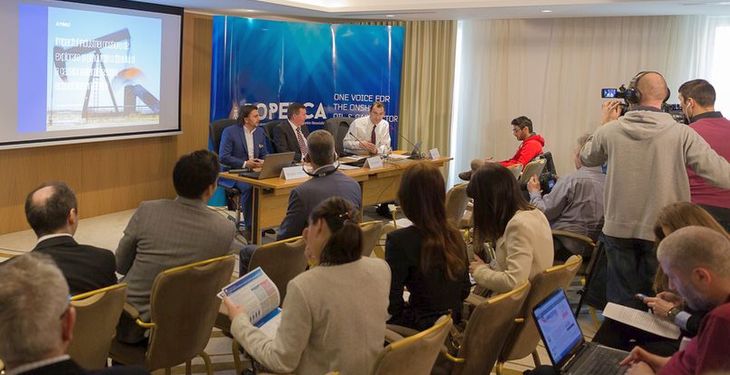* Each euro invested in exploration and production of oil and gas tripled in the Romanian economy, according to a study realized by consulting firm KPMG at the request of the Romanian Association of Petroleum Exploration and Production Companies ROPEPCA. Specifically, an investment of 1 billion euros generates a EUR 3.2 billion contribution in GDP from the sector.
* Approximately EUR 1 billion is the estimated spend by the companies in the sector to bring new wells into production or to invest in existing technology which increases the recovery rates of mature oil and gas fields.
* Without these investments, Romania risks remaining without domestic production of natural gas and crude oil in 9 or, respectively, 12 years.
* An investment of EUR 1 billion generates approximately 25,800 jobs created or maintained in the upstream oil and gas sector and across its supply chain and approximately 20,100 in other sectors of the economy
* Money spent in onshore upstream almost symetrically transfer in tax revenues for Romania, during the investment and production intervals. “An investment of EUR 1 billion generates a sector contribution of EUR 1 billion in government tax revenues, in 11 years” says KPMG study.
All these figures are extracted from the study realized by KPMG and they are new arguments for the industry to ask for support from the authorities in a period when they are working on a new taxation regime for hydrocarbon resources. Under the provisions introduced in 2004, the royalties for oil and natural gas production are imposed at rates between 3.5% and 13.5%.
Investments blocked, pending the new tax regime
Most of the 400 oil deposits that are currently in operation, have small productions and are taxed close to the minimum level of the royalties. The authorities announced that they want to increase the budget revenues from the hydrocarbon industry and it seems the most likely innovation is the introduction of a so-called oil tax applicable on the profits of companies. It is not yet clear how it would operate and how the investment costs will be deducted.
“What we want is that the new tax regime, no matter how it will look, to apply only to the new concession agreements, not to the old ones,” said Artur Stratan, President of the ROPEPCA in the presentation conference of the study performed by KPMG. “Moreover, the state should encourage companies in the sector by reducing the level of taxation for the deposits already in production”, said Stratan, who explained that this support is necessary not only for the extension of the life of the deposits in operation, but, first of all, to ensure their survival this year. Many deposits are already unprofitable because of the very low price of oil and the President ROPEPCA expects that 20-30 deposits from this category to be closed by the holders.
Mandatory investments to maintain production
Romania is one of the European countries with the largest reserves of natural gas, with proven reserves of over 640 million barrels of oil equivalent (bep). However, without constant and significant investments, these reserves will cover only about 9 years of production of natural gas. The same situation is seen in terms of oil reserves (over 315 million bep), which, due to lack of investments, can only cover about 12 years of oil production.
Industry representatives assessed at about one billion euro the annual capital investment needed, in order to maintain the production level stable. Money which also contribute to the creation and maintenance of about 45,900 jobs, of which 25,000 direct in the industry exploration and production of crude oil and natural gas.
Investments to provide a future for the industry
Artur Stratan referred to the information communicated in 2015 by Prospectiuni S.A., according to which only 10% of Romania’s subsoil is prospected using modern technologies, such as 3D seismic analysis. Which adds to the fact that the vast majority of the deposits in production are located at depths below 3,500 meters. Deep sea areas could reveal new reserves and perhaps more productive, but to access these clarity and stability in the tax regime is required, applicable to the industry, as well as the opening from the authorities. The exploration for oil and gas activity, requires an intensive capital consimption and a high risk of failure. “The new tax regime will have to be pro-business, because investments here rival those from other countries, and there are very few opportunities in Romania”, said Stratan.
The members of ROPEPCA performed in 2014 investments of up to 1.5 billion euros, and their contributions to the state budget amounted to 2.5 billion euros. The economic impact was generated by both the exploration and production of oil and natural gas, and the activities of refining and distribution of petroleum products and natural gas, performed by the ROPEPCA members with integrated activities.
The Romanian Association of Companies of Exploration and Production Oil, ROPEPCA was established in 2012 and now includes 19 of the most active members in the onshore industry: ADX Energy, Amromco, Aurelian Petroleum, Bankers Petroleum, East West Petroleum, Expert Petroleum, Fora Oil & Gas, Hunt Oil Company of Romania, Moesia Oil & Gas, NIS Petrol, Oilfield Exploration Business Solutions, OMV Petrom, Panfora Oil and Gas (MOL Group), Raffles Energy, Repsol, Sand Hill, Stratum Energy, Winstar Satu Mare / Serinius Energy, Zeta Petroleum.
